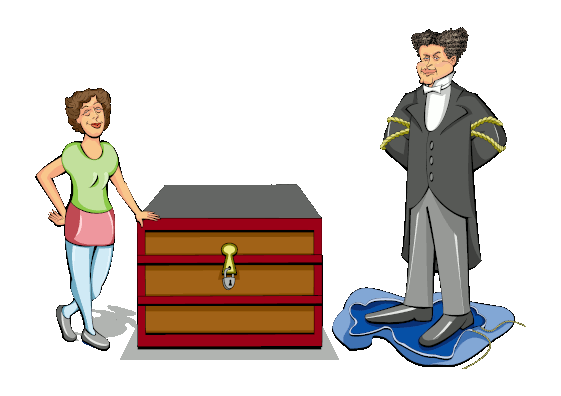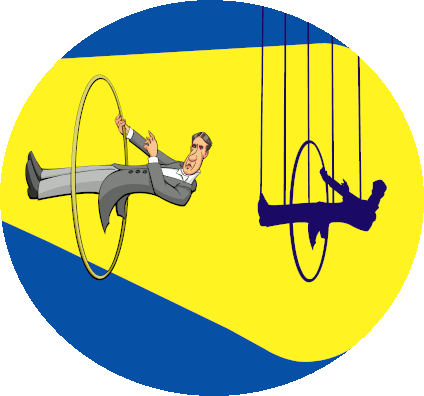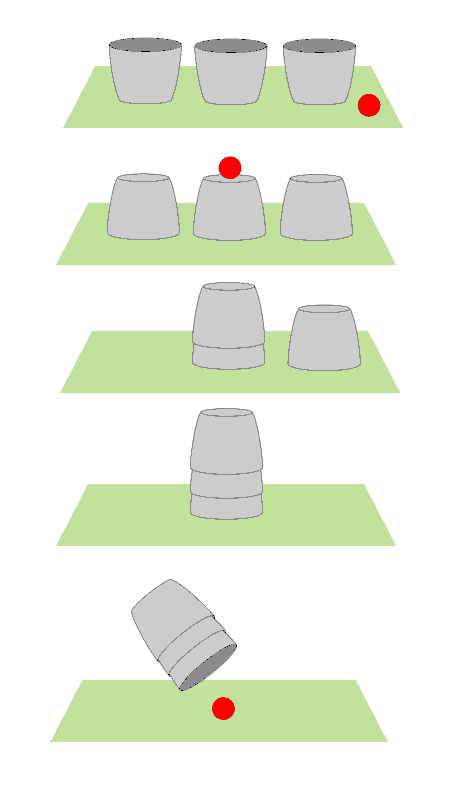Dai Vernon
The Prof

(Click on the image to zoom in and out.)
| "Even to this day such great magicians as Dai Vernon and Francis Carlyle consider the cigar smoking one of my magic props. But if it is, I'm not telling." | |
| ‐ | John Scarne, The Odds Against Me. |
Those who have read the books written by John Scarne know he didn't heap praise lightly. So if John called Dai Vernon a great magician, then you can be assured John really thought that Dai was a great magician.
In fact, Dai has been cited as perhaps the best close-up sleight of hand magician ever and has been called a magician's magician - "The Professor". Among the many illusionists he taught and mentored were close-up magician Michael Skinner, magician and humorist John Carney, Dai's fellow Canadian Doug Henning, and Persi Diaconis - whose "day job" just happens to be professor of mathematics at Stanford University.
One of Dai's major performing venues was The Magic Castle, a private nightclub in Los Angeles for top-notch professional magicians. But before he settled down in California, Dai spent much of his time touring the world where in his youth he met Harry Houdini.
The oft told story is that Dai was performing card tricks for Harry. In one trick Harry wrote his name on a card and Dai slowly and clearly put it in the middle of the deck. Then he slowly and carefully removed the top card and there was the card with Harry's name. Harry kept asking Dai to do the trick again. After a while the others who were watching - including Harry's wife Bess - turned to him and said, "Admit it, Houdini1, you're fooled!"
Footnote
That Bess would call her husband by his stage name seems strange. After all, when she met Harry, his family called him "Erie" although at that point the name had likely been Americanized to "Harry" by his neighborhood chums. His family name was Weisz or Weiss.
However, in 1913, Harry had his name legally changed. In fact, when he set off that year for one of his many European tours, he was Erik Weiss. But when the boat docked in England, he was Harry Houdini. And there is other attestation that Bess indeed referred to Harry as Houdini and her cemetery marker reads "Wilhelmina Beatrice Houdini".

Harry and Bess Houdini
(She called him "Houdini".)
Dai has also been credited with creating the modern Cups and Balls illusion. The trick's origins are lost to antiquity although the picture from the Egyptian tomb of Baquet II at Beni-Hasan is sometimes cited as its earliest representation. Actually, it's probably a couple of guys stacking bread.

Cup and Balls at Beni-Hasan
It's probably bread.
That said, the trick definitely goes back hundreds of years and may have been depicted in a famous painting by Hieronymus Bosch. However, Heironymous's painting may be of the trick's predecessor, the street gambling "shell game" where the magician puts a ball under one out of three cups, rapidly scrambles them, and the viewers bet on which cup the ball is under. A skilled sleight of hand artist would guarantee that the ball wasn't under the cup selected.
In the modern version the magician places three apparently empty cups upright on a table. Then they're all turned upside down and the magician places a ball on the top (ergo, the bottom) of the center cup. Finally he stacks on the other cups, thus concealing the ball.
As always the magician makes a "magical gesture" or says a "magic word". Then he lifts the stack up, showing the ball is on the table. So it looks like the ball has passed through the bottom of the lowest cup!
The cup is replaced over the ball and a second ball placed on top. The other cups are again stacked on top and with another magical gesture, the cups are lifted up showing TWO balls under the cups. So it looks like the other ball went through the bottom of the cup. The process is repeated with a third ball and it looks like you've made three balls magically pass through the cup.
This is the "Basic Cup and Balls Trick", and it's actually pretty easy to do even for beginning magicians. No fancy equipment is needed. You can use simple paper cups and even the balls can be made on the spot using crumpled up paper or aluminum foil. For this reason it's a good "pub" trick.
However, more advanced variations are performed by professional magicians. For instance, the magician can take one of the balls, place it on top of one of the cups, stack the others on top, and - with a gesture - lift the cups to show the ball has vanished. He might then make the ball re-appear. Or he can take one of the balls, put it in his pocket, and then have it appear under a cup that was previously shown to be empty. The ball might even be found on a member of the audience who volunteered to come on stage.
The finale of the trick is to have a final "load" appear. That is, after the ball vanishes from under a cup, the magician replaces the cup face down, only to lift it up and find a larger object - a baseball or an onion - has appeared under the cup.
Dai is credited with establishing the modern standards for the trick. Dai's modus magicerandi included rapid fire execution and even letting the audience members decide under which cup the ball would reappear. Naturally these advanced versions aren't for the beginner. What's even more impressive is that Dai can tell the audience how he's doing the trick - and he still fools them!
David Frederick Wingfield Verner was born in 1894, a time that was still the "Golden Age of Magic". He began performing magic tricks for school and church functions and when the Great Howard Thurston came to Ottawa, it's said that the seven year old David fooled the World's #1 Illusionist with a card trick.

Howard Thurston
Dai fooled him.
Dai's folks, particularly his mom, didn't take to his ambition to be a stage magician. But since he did show artistic talent his parents decided he should go to New York to study at the Art Students League. New York, though, was probably the worst place to send a kid to deter performing aspirations. Magicians were everywhere and you'd see them every weekend at Coney Island.
But in 1914 came the War That Didn't End All Wars (remember Dai was Canadian). So he returned home and entered the Royal Military College of Canada. Although he wanted to join the overseas expedition, his drawing skills landed him a desk job. When the war was over he headed back to New York.
And to heck with art, he said. He was going to be a magician, and Dai quickly found his way to Al Flosso's Magic Shop. It only took a few tricks for Al to get him invited to the backroom where the top magicians swapped their tricks.
Of course one of the magicians in Flosso's Inner Sanctum was Harry Houdini, today the most famous magician in history. Dai, though, didn't think Harry was really a top conjurer. Certainly he acknowledged that Harry was a great performer and escape artist. But that wasn't magic. How good Harry was as an illusionist is still a matter of debate but the consensus (bolstered by some film clips) is he had the skills to perform as a professional but he wasn't one of the best.
New York in the Roaring Twenties was the place to be for aspiring performers. Not only were there audiences wanting entertainment, there were rich audiences wanting entertainment - if the entertainment was good. It wasn't long before Frances Rockefeller King - New York's booking agent for the rich and powerful - tapped Dai on the shoulder and offer him a princely $5000 for a month's worth of performances. He was booked for parties and clubs which boasted New York's richest guests - the Astors, the Vanderbilts, and yes, the Rockefellers. His minimum fee for a single performance was $100 - good money in the 1920's - and for some shows that was upped to $300.
Of course, the years of the 1920's included the year 1929. The Great Depression soon put a damper on the demands for a top notch card magician. Like many others Dai found jobs when and at what he could. He even worked as a silhouette artist cutting profiles in paper.
By this time Dai was married to Eugenie Hayes (Jeanne to her friends). Living with Dai was not always easy not least reason being if the rent came due and they didn't have it Dai just didn't worry about it. Jeanne never knew that if she went out of the apartment she might return to find their furniture sitting out on the sidewalk. Such a lifestyle couldn't last and eventually Jeanne moved out. Although officially they remained married, they never saw each other again.
Although economists still debate what ended the Great Depression, some who actually lived through it say the program that cured the country's economic ills was World War II. Although he was overage for a combat soldier, Dai was appointed captain in the entertainment corps. The end of the war brought back prosperity, but unfortunately his close up magic didn't always work in the larger theaters. A booking at Radio City Music Hall was a flop and didn't run more than two days.
Dai decided to try a "real" job working at the docks. At one point he was carrying some buckets to a ship when the plank broke. When he hit the deck he broke both arms so badly that the doctors said his left arm would have to be amputated. Dai refused and he was never able to straighten his arm completely after that. But he took the accident as an omen, particularly after John Scarne - who Dai called a very good card man - paid him a visit. "That just goes to show you," John said, "that guys like you and me shouldn't work."
Dai finally realized that although he liked doing magic tricks for people, he didn't actually like performing before a theater audience. So a good compromise was to return to working close up jobs like private parties. Another lucrative venue was to perform on tour ships which at that time catered only to the rich and elite. But what Dai really liked was arranging lectures to professional magicians. These were well attended and while in London he was recognized by England's famed Magic Circle.
It was in the late 1950's that Dai became the mentor of Persi Diaconis, then a teenager who had dropped out of Julliard. They toured the country, performing magic shows, but they also used the travels to seek out hucksters and gamblers who had developed new moves. Persi later went to Harvard to earn his doctorate in mathematics and then moved to his day job in Palo Alto.
Even before the war the entertainment industry has begun shifting to Hollywood and Dai soon moved to Los Angeles where he became one of the regulars at the magicians night club The Magic Castle. There he became "professor" and mentor to the other elite magicians who gathered there.
Dai kept performing into his 90's but at age 96 he broke his hip. He then moved in with one of his sons and was largely confined to his bed. Although for the last two years of his life Dai wasn't able to perform, he was always happy to when his friends and former students stopped by.
Among the East and West Coast Rivalries that arose from Dai's move to Los Angeles was the dispute on how to pronounce his name. "Dai" was simply a shortened version of "Dave" and in the early years in New York everyone pronounced it as "Day". But on the West Coast, the name began to be rendered as "Dye". As usual when it came to controversies, Dai just shrugged his shoulders. When anyone asked Dai how his names was pronounced, whether it was "Day" or "Dye", he'd reply, "'EE-ther' or 'EYE-ther'".
References
"Dai Vernon", Genii Magazine, Magicpedia.
The Odds Against Me, John Scarne, Simon and Schuster, 1966.
Houdini: His Legend and His Magic, Doug Henning (with Charles Reynolds), Warner Books.
The Magic Castle, The Academy of Magical Arts.
"The Cups and Balls", Rings-N-Things
Beni Hasan, Part II, Percy E. Newberry, Archoelogical Survey of Egypt, F. L. Griffith (Editor), Egyptian Exploration Fund, 1893.
"Dark Art: Spectacular Illusions from the Golden Age of Magic", Hunter Oatman-Stanford, Collector's Weekly, February 5th, 2014.
Dai Vernon: The Spirit Of Magic (also The Canadians: Dai Vernon), Daniel Zuckerbrot (director), Patrick Watson (director), Historica Canada.
"Bess Radner Houdini", Find-a-Grave, December 31, 2000.
